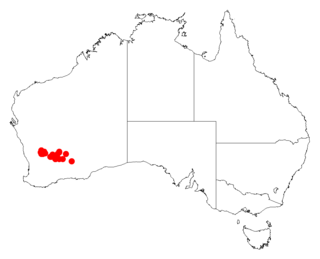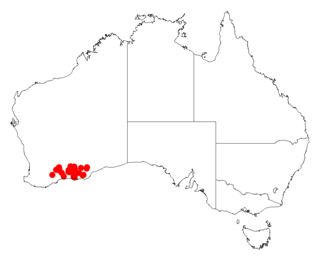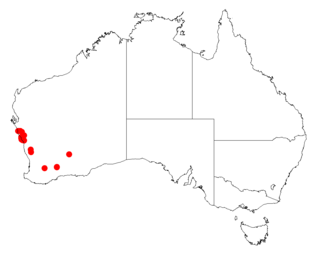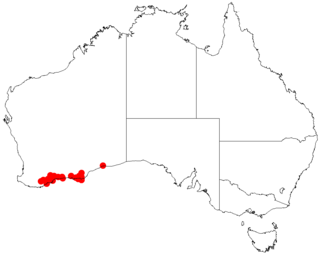
Acacia papyrocarpa, commonly known as western myall, is a tree in the family Fabaceae native to arid areas of central and western Australia.

Acacia glaucoptera, commonly known as flat wattle or clay wattle, is a species of Acacia which is endemic to the south-west of Western Australia.

Acacia pubescens, also known as the downy wattle, is a species of wattle found in the Sydney Basin in eastern New South Wales. The downy wattle is classified as vulnerable; much of its habitat has vanished with the growth of the city of Sydney.

Acacia continua, or the thorn wattle, is a shrub belonging to the genus Acacia and the subgenus Alatae. It native to New South Wales and South Australia.

Acacia conniana is a shrub belonging to the genus Acacia and the subgenus Juliflorae that is endemic to the southern coast of western Australia.

Acacia cylindrica is a shrub belonging to the genus Acacia and the subgenus Juliflorae that is endemic to western Australia.

Acacia leptophleba is a shrub belonging to the genus Acacia and the subgenus Juliflorae that is endemic to northern Australia.

Acacia concolorans is a shrub belonging to the genus Acacia and the subgenus Phyllodineae that is endemic to Western Australia.

Acacia erinacea, also known as prickly wattle, is a shrub belonging to the genus Acacia and the subgenus Phyllodineae that is native to Western Australia.

Acacia errabunda is a shrub belonging to the genus Acacia and the subgenus Phyllodineae native to Western Australia.

Acacia euthyphylla is a shrub belonging to the genus Acacia and the subgenus Phyllodineae native to Western Australia.

Acacia evenulosa is a shrub belonging to the genus Acacia and the subgenus Phyllodineae native to Western Australia.

Acacia heterochroa is a shrub belonging to the genus Acacia and the subgenus Phyllodineae that is endemic to south western Australia.

Acacia leptopetala is a shrub belonging to the genus Acacia and the subgenus Phyllodineae that is endemic to an area of south western Australia.

Acacia oxyclada is a shrub belonging to the genus Acacia and the subgenus Phyllodineae that is endemic to western Australia.

Acacia benthamii is a shrub of the genus Acacia and the subgenus Plurinerves. It is native to an area along the west coast in the Perth metropolitan region and Wheatbelt region of Western Australia.

Acacia loxophylla is a shrub of the genus Acacia and the subgenus Plurinerves that is endemic to an area of south western Australia.

Acacia nitidula is a shrub of the genus Acacia and the subgenus Plurinerves that is endemic to an area along the south coast of south western Australia.

Acacia triptycha is a shrub or tree of the genus Acacia and the subgenus Plurinerves that is endemic to an area of south western Australia.

Acacia leichhardtii, commonly known as Leichhardt's wattle, is a shrub of the genus Acacia and the subgenus Phyllodineae that is endemic to north eastern Australia.




















